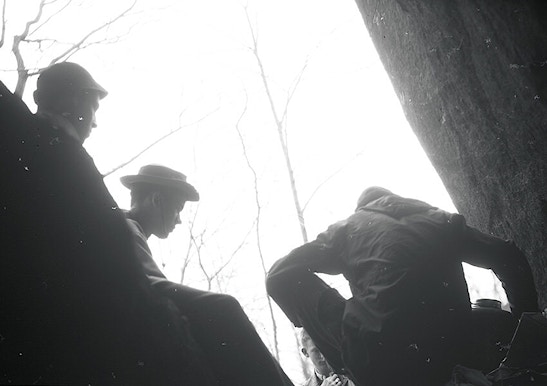
Bucks County Caves Map
Explore the Caves of Bucks County
This map highlights the locations of nine caves in Bucks County that appear in legends about the Doan Gang. The Doans' use of these caves as hideouts or places to conceal stolen treasure remains unproven. The caves do, however, illustrate Bucks County's rich geologic history. Local cave exploration continues even today.
Map Legend
 River Mud
River Mud
 Trenton Gravel
Trenton Gravel
 Red and Yellow Gravel and Clay
Red and Yellow Gravel and Clay
 Wealden Clay
Wealden Clay
 Trap
Trap
 Mesozoic
Mesozoic
 Serpentine
Serpentine
 Philadelphia and Manayunk Schists
Philadelphia and Manayunk Schists
 Siluro Cambrian Limestone
Siluro Cambrian Limestone
 Potsdam Sandstone or Edge Hill Rock
Potsdam Sandstone or Edge Hill Rock
 Gneiss
Gneiss

1. Buckingham Cave
Buckingham Cave is located on the former property of County Coroner William Bennett, who examined Moses Doan's body after his death at Halsey's Cabin. In 1859, it was rediscovered by teacher Joseph Fell and local schoolchildren. Inside, they claimed to have found a carved inscription, "`1775 M. Doan." The cave has since been excavated by multiple Bucks County residents seeking to verify this report.

2. Wolf Rocks
Wolf Rocks was located on Buckingham Mountain. The cave gained fame as the rocky residence of a mid-nineteenth century hermit. In an 1880s interview with Henry C. Mercer, James Raylman, descendant of Doan Gang member Jeremiah Cooper, claimed that the Doans used Wolf Rocks as one of their hideouts.

3. Finland Cave
Finland Cave is part of a larger network of rock shelters and caves near the village of Finland. The cave is featured in legends of hidden Doan Gang treasure guarded by a phantom hound. Amateur archaeologist William Strohmeier explored Finland Cave in the 1950s and found no trace of the Doans. He did, however, find evidence of indigenous communities who had once lived there.

4. Doan’s Cave
This cave is located in Ralph Stover State Park. It is known locally as Doan's Cave due to its proximity to Halsey's Cabin where Moses Doan was killed. Author John P. Rogers first suggested that the Doan Gang hid inside this cave during the summer of 1783. When they ran out of food, according to Rogers, they were forced to relocate to Halsey's Cabin.

5. Durham Cave
In folktales about the Doan Gang, Durham Cave–also called "Devil's Hole"–was often the site of meetings where the Gang plotted their robberies. Henry C. Mercer surveyed Durham Cave in the Fall of 1893. Although he did not discover any eighteenth-century artifacts, he did find several indigenous artifacts and animal bones.

6. Pillory Rocks
Pillory Rocks is located on Jericho Mountain. In an 1880s interview with Henry C. Mercer, James Raylman, descendant of Doan Gang member Jeremiah Cooper, claimed that the Doans used Pillory Rocks as one of their hideouts.

7. Devil's Cave
Devil's Cave, located near Newtown, was first thought to be a Doan Gang hideout when its discovery was published in 1868. This cave was eventually filled in. No evidence has been found to suggest it was used by the Doans.

8. Solebury Copper Mine
This abandoned mine is located on Bowman's Hill in Washington Crossing State Park. It likely predates the arrival of William Penn and the creation of Bucks County. Mining tools found on the site are believed to be Dutch, and date to the 1600s. In an 1880s interview with Henry C. Mercer, James Raylman, descendant of Doan Gang member Jeremiah Cooper, claimed that the Doans used this mine as one of their hideouts.

9. Haycock Mountain Cave
Haycock Mountain Cave–now a popular rock climbing destination–was first linked to the Doan Gang in 1963. That year, a local newspaper reported that a carved signature, "M. Doan," was discovered on its wall.
